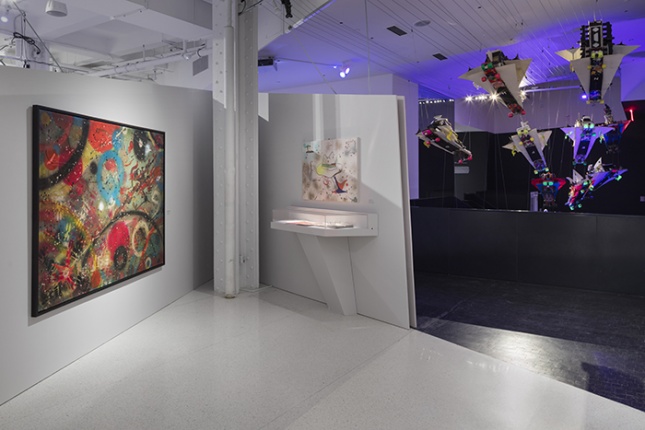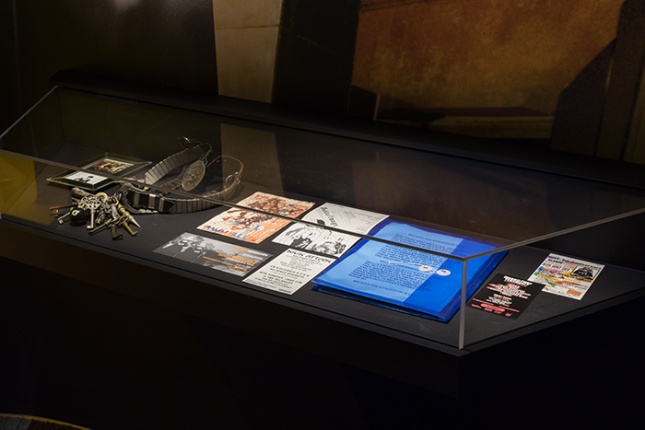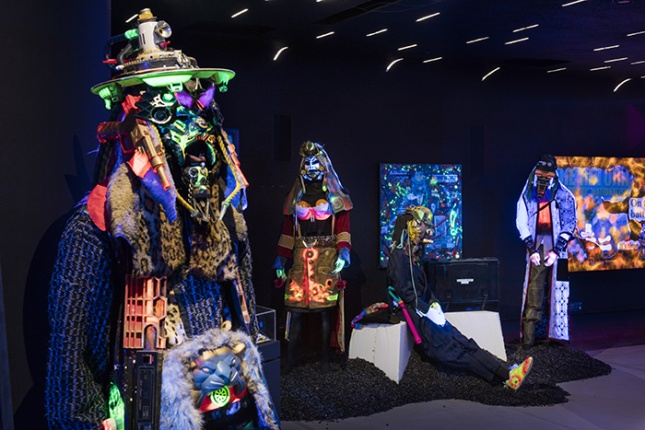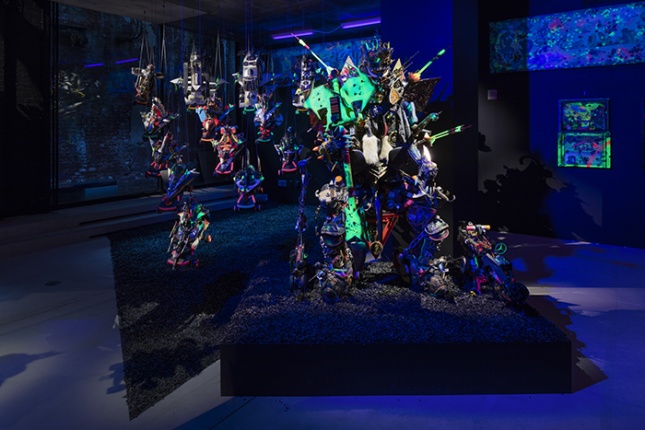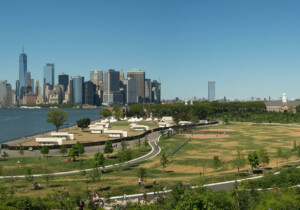Rammellzee (1960–2010), a seminal New York artist, is finally getting his due with the expansive and explosive two-floor retrospective RAMMΣLLZΣΣ: Racing for Thunder at Red Bull Arts New York. The celebration of this multi-hyphenate artist, writer, and musician is no staid, white cube exhibition. The paintings, sculptures, videos, drawings, and ephemera that comprise the exhibition are brought to life in a deservedly elaborate space designed by studioSTIGSGAARD, helmed by its namesake architect Martin Stigsgaard, also of Voorsanger Architects.

Though perhaps no longer as well-known as some of his contemporaries, Rammellzee was certainly renowned in the downtown scene in the 1980s and 90s. Referred to as the “King of the A Line” for his tagging chops during his early street art days, he collaborated with the likes of Jean-Michel Basquiat (who designed the album art for one of his music releases) and appeared in numerous films, including Jim Jarmusch’s cult classic Stranger than Paradise (1984). At the peak of his notoriety and commercial success, Rammellzee rejected art world trappings and retreated to his Tribeca loft, which he called the Battle Station, where he would spend 20 years working on his Gesamtkunstwerk, a constantly evolving mythical world.
Stigsgaard’s design, which was developed in close collaboration with curators Max Wolf, Carlo McCormick, Candice Strongwater, Jeff Mao, and Christian Omodeo, honors the legacy of Rammellzee’s Battle Station, without trying to replicate it, something they felt could not be done by anyone except Rammellzee himself. Instead, Stigsgaard tried to “create a framework…to set his work off,” relying on the body of work to bring visitors into his world while still providing an intelligible timeline and order in an immersive environment.

Upon entering the exhibition space you are confronted with a tunnel of mesh walls with irregular, geometric apertures that create a spatial “compression.” Stigsgaard says this references not only a subway tunnel, the site where Rammellzee first began mobilizing language by tagging the A train in Far Rockaway, Queens, but also a tank firing range, apt for an artist who felt that he was leading a war against the cultural tyranny of the alphabet.
Down the tunnel are some of Rammellzee’s early visual works, as well as a script he developed, and an original 12th-century manuscript. The manuscript serves as a touchstone for Rammellzee’s approach to language as a visual, and eventually, performative and spatial, practice and his self-identification as a “gothic futurist.” He was constantly fighting against normative order—his own manifesto Gothic Futurist describes the symbolic battle of letters against the alphabet’s stultifying standardization, as realized in his graffiti and his later Letter Racers.

The central upstairs gallery manifests Rammellzee’s military obsession and his invented linguistic theory of “Ikonoklast Panzerism.” For this space, Stigsgaard used what he described as Panzerkeil formations, which refer to a V-shaped arrangement of tanks used by the Germans on the Eastern Front. The formation leads to a strong exterior defense with a weaker interior. Here, the formation acts as the parti for the exhibition space; the structure presents a full-frontal approach for larger work with a more intimate interior to observe smaller pieces, simultaneously organizing the space and causing one to be “put off balance.” The formation’s visual logic extends even to the angular vitrines and other details.
The final stage upstairs exemplifies the unorthodox use of lighting in the exhibition. Shifting on a timer, the lighting in this last space goes between the usual white light to black light that makes Rammellzee’s paintings and sculptures pop and glow. As you come around towards the stairwell, you see Rammellzee’s Letter Racers, hung ready for battle, spiraling downstairs. These Letter Racers are 26 fighter plane-style assemblages of detritus and consumer goods mounted on skateboards and remote-controlled cars, each a letter in Rammellzee’s invented alphabet. Light confronts you in your face as you take their mass in. This is hardly unintentional. As Stigsgaard says, “It’s not about creating a comfortable lighting. I like that you get a big blast in your face. This is not a white box, ordinary gallery. You need to be a little bit thrown off.”
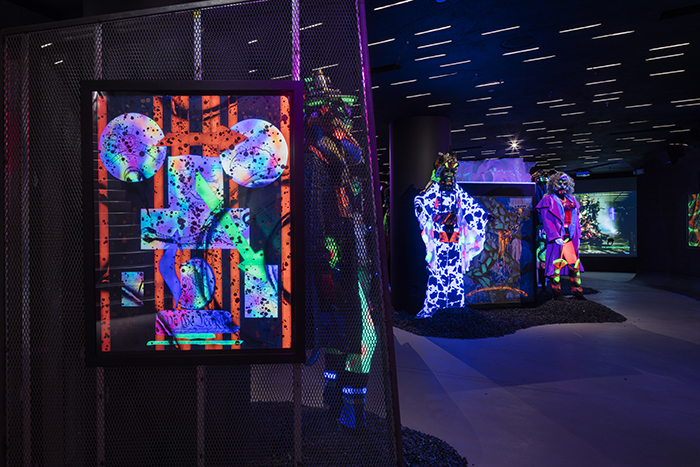
The downstairs takes on a more cave-like quality. Ceilings are low and the space is almost unnervingly dark. We have entered the physical realization of the 25th century, a major era in Rammellzee’s extensive cosmology. Metal mesh walls that conceal and reveal—again in Panzerkeil formation—are on islands of what at first appears to be stone or gravel, but upon closer investigation are shredded tires. Here are perhaps the most memorable pieces in the exhibit, his Garbage Gods, full-scale armored sculptural costumes made of found objects and sidewalk trash. This cast of characters each has their own place within Rammellzee’s sci-fi mythology, with personalities he would adapt by wearing and performing the costumes.
In the rear of the space is a glowing polystyrene “rock formation” that holds scale model Garbage Gods in its niches. This strange hybrid of natural and artificial, urban and prehistoric, creates a space that Stigsgaard describes as “outside of time.” The gothic meets the space-age, suits accumulate and reconfigure the histories of the found objects that comprise them, boundaries breakdown and time falls into itself—both in Rammellzee’s art and in the design of the space.
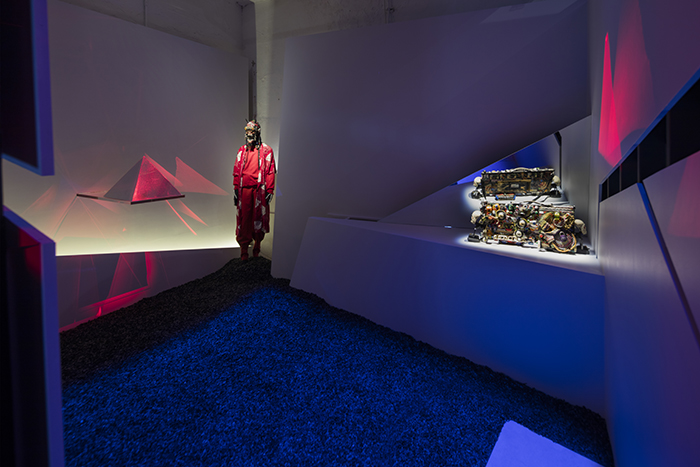
After passing the final massive Garbage God, slivers of red light hint at an additional space. Though relatively large, tire shreds take up most of the room, allowing you just small passage. At dead center is a pyramid. Suspended on acrylic it seems to be floating. Red light hits its reflective surface, again creating an almost blinding moment. Lurking in the right corner is another Garbage God and at the right is one of Rammellzee’s bricolage luggage pieces. The room certainly feels significant and has a certain stillness, but without reading the wall text the space’s real weight might be missed. This pyramid is an urn, designed by Rammellzee, to contain his own ashes. This Garbage God is Reaper Grimm. This luggage is what he wished to carry into the next life. It is here, with Rammellzee present, that you realize this is no mere exhibition; this is a temple, or perhaps even, a mausoleum.
RAMMΣLLZΣΣ: Racing for Thunder
Red Bull Arts New York
220 West 18th Street, New York, NY
Through August 26th








